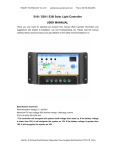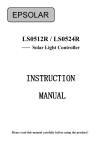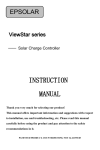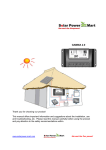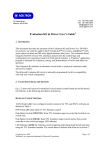Download User manual for PU1024WP Photonic Universe 10A 12V/24V
Transcript
10A / 20A Waterproof Solar Charge Controller PU1024WP / PU2024WP series INSTRUCTION MANUAL Dear Customer, Thank you very much for choosing our product. This manual contains important information about the installation and operations of your charge controller. Please read this manual carefully before installation and pay special attention to the safety recommendations. 10A / 20A Waterproof Solar Charge Controller PU1024WP / PU2024WP series Specification Summary Nominal system voltage 12 / 24VDC* Maximum PV input voltage 50V Nominal charge / discharge current PU1024WP 10A PU2024WP 20A * The controller will determine the system rated voltage at start up. If the battery voltage is lower than 18V, it recognises the system as 12V. If the battery voltage is greater than 18V, it recognises the system as 24V. Contents 1. Important Safety Information ............................ 1 2. General Information ......................................... 2 2.1 Product Overview ....................................... 2 2.2 Product Features ........................................ 3 3. Installation Instructions ..................................... 4 3.1 General Installation Notes ........................... 4 3.2 Mounting .................................................... 5 3.3 Wiring ......................................................... 6 4. Operation ....................................................... 10 4.1 PWM Technology ..................................... 10 4.2 Battery Charging Information .................... 11 4.3 LED Indicators .......................................... 13 4.4 Setting Operation ...................................... 15 5. Protection, Troubleshooting and Maintenance 18 5.1 Protection ................................................. 18 5.2 Troubleshooting ...................................... 19 5.3 Maintenance ......................................... 21 6. Warranty ........................................................ 22 7. Technical Specifications ................................. 23 1. Important Safety Information Read this carefully This manual contains important information about the safe installation and operations of the charge controller. The following signs are used throughout this manual to indicate potentially dangerous conditions or mark important safety recommendations. Please pay special attention when you see these signs: WARNING: Indicates potentially dangerous conditions. Use extreme caution when performing this task. CAUTION: Indicates a critical procedure for safe and proper operation of the controller. NOTE: Indicates a procedure or function that is important for the safe and proper operation of the controller. General Safety Information • Read the full instruction manual before installing the solar • There are no parts serviceable by users. Do not disassemble • Install external fuses/breakers as required. • Disconnect the solar module and fuse / breakers before • Confirm that power connections are tightened to avoid charge controller. or attempt to repair the controller. installing or adjusting the controller. excessive heating from a loose connection. 1 2. General Information 2.1 Product Overview Thank you for choosing this Photonic Universe waterproof solar charge controller, which uses advanced digital technologies and operates in a fully automated mode. One of the features of this controller is Pulse Width Modulation (PWM) battery charging technique which can increase the lifetime of your battery and improve performance of the solar system. Other features of this controller include: • 12V / 24V automatic recognition. • High efficiency Series PWM charging - extends the life of your • Use of MOSFET as an electronic switch, without any • Automatic recognition of day and night. battery and improves charge acceptance. mechanical switch. • Digital LED menu, with only one key to select all settings. • Intelligent timer function with 1-15 hours option. • Unique dual timer function which makes the controller a • Waterproof design, suitable for environments with high • Gel, Sealed and Flooded battery type options. • Adopts temperature compensation, corrects the charging and perfect choice for solar lighting systems. humidity or dust. discharging parameters automatically and extends battery life. • Electronic protection from over charging, over discharging, overheating, overload, short circuit and reverse current. • Reverse polarity protection: any combination of solar module and battery. The controller is designed for off-grid solar systems, including solar lighting. It protects the battery from being over charged by the solar module and over discharged by the load. The charging process is optimised for long battery life and improved system performance. The comprehensive self-diagnostics and electronic protection functions 2 can prevent damage from installation mistakes or system faults. Though the controller is easy to operate and use, please take your time to read this manual and become familiar with it. This will help you make full use of all the functions and improve performance of your solar PV system. 2.2 Product Features 1 2 3 4 5 6 7 8 9 11 10 Figure 2-1 Solar Charge Controller features 1. Temperature sensor Measures ambient temperature and makes temperature compensation for charging and discharging. 2. Charging status LED indicator An LED indicator that shows charging status and also indicates when battery voltage is higher than battery over-voltage disconnect voltage. 3. Battery status LED indicator An LED indicator that shows battery status and remaining charge. 4. Battery type setting indicator 3 The indicator will be on when you select the battery type. 5. Timer 2 setting indicator The indicator will be on when you set timer 2. 6. Timer 1 setting indicator The indicator will be on when you set timer 1. 7. LED digital display Display the load work mode and status. 8. Setting button (in manual mode used for load ON/OFF) Sets load work mode and selects battery type. 9. Solar module cables Cables for connecting solar modules. 10. Battery cables Cables for connecting battery or battery bank. 11. Load cables Cables for connecting loads. 3. Installation Instructions 3.1 General Installation Notes • Read through the entire installation section first before • Be very careful when working with batteries. Wear eye beginning the installation. protection and gloves. Have fresh water available to wash with immediately and clean any contact with battery acid. • Use insulated tools and avoid placing metal objects near the • Batteries might produce some explosive gasses during batteries. charging. Make sure there is sufficient ventilation in the work area. • Avoid letting the batteries be exposed to direct sunlight during • Loose power connections and/or corroded wires may result in outdoor installation. 4 resistive connections that melt wire insulation, burn surrounding materials, or even cause fire. Ensure connections are tight and use cable clamps to secure cables and prevent them from swaying in mobile applications. • Use with Gel, Sealed or Flooded batteries only. • The battery connection may be wired to one battery or a bank of batteries. This manual refers to a single battery, but the battery connection can be a group of batteries in a battery bank. • Select the system cables based on 3.5A / 1 mm2 cable cross section. 3.2 Mounting NOTE: When mounting the controller, ensure air can circulate through the controller heat sink. There should be at least 6 inches (150 mm) of clearance above and below the controller to allow for cooling. If mounted inside, ventilation is strongly recommended. WARNING: Risk of explosion! Never install the controller in a sealed case with flooded batteries. Do not install in a confined area where battery gases can accumulate. Step 1: Choose mounting location Position the controller on a vertical surface protected from direct sunlight, high temperatures and water. Ensure there is adequate ventilation. Step 2: Check for clearance Place the controller where it will be mounted. Verify that there is sufficient room to run wires and clearance above and below the controller for air flow (see Figure 3-1). 5 150mm (6 inches) Warm air 150mm (6 inches) Cool air Figure 3-1 Mounting and cooling Step 3: Mark holes Use a pencil or pen to mark the four (4) mounting hole locations on the mounting surface. Step 4: Drill holes Remove the controller and drill holes in the marked locations. Step 5: Secure controller Place the controller on the surface and align the mounting holes with the drilled holes in step 4. Secure the controller in place using the mounting screws. 3.3 Wiring NOTE: A recommended connection order has been provided for maximum safety during installation. NOTE: The controller is a common positive ground controller. If your system (e.g. vehicle or boat) is a negative common ground system, you can still use the controller, but you SHOULD NOT use earthing of any “+” or “-“ cables, even if it’s shown on the diagrams below. 6 CAUTION: Do not connect the loads with surge power exceeding the rating of the controller. CAUTION: For mobile applications, be sure to secure all wiring. Use cable clamps to prevent cables from swaying when the vehicle is in motion. Unsecured cables create loose and resistive connections, which may lead to excessive heating and/or fire. Step 1: Battery wiring WARNING: Risk of explosion or fire! Never short circuit battery positive (+) and negative (-) or cables. Before the battery is connected, make sure the battery voltage is greater than 6V so as to start up the controller. If the system is 24V, make sure the battery voltage is not less than 18V. System voltage will be automatically recognised when the controller starts up for the first time. Fuse 150mm (6 inches) MAX Battery Figure 3-2 Battery connection 7 When installing the fuse, make sure that the distance between the fuse holder and the positive terminal of the battery is no more than 150mm. Do not insert a fuse at this time. Step 2: Load wiring The controller load cables can be connected to electrical equipment, such as lights, pumps, motors etc. which have the same working voltage as the battery. Connect the positive (+) and negative (-) of loads to the controller load cables as shown in Figure 3-3. An in-line fuse holder should be wired in series in the load positive (+) or negative (-) wire as shown in Figure 3-3. Do not insert a fuse at this time. When wiring the load connection to a load distribution panel, each load circuit should be fused separately. The total load draw should not exceed the rated load current of controller. Load Fuse Figure 3-3 Load Wiring It is unnecessary to connect any load to load cables of the charge controller if your system is intended for battery charging only. Load cables can be left unconnected, however they must be insulated to prevent short circuit. 8 Step 3: Solar wiring WARNING: Risk of electric shock or sparks! Exercise caution when handling solar wiring. Cover the solar module(s) before wiring them to the charge controller. The controller can accept 12V, 24V nominal off-grid solar module(s). Grid-tie solar module(s) may be used if their open circuit voltage does not exceed the maximum PV input voltage of the controller. NOTE: the controller cannot work with non-PV sources of input power. For example, it is not suitable for wind turbines. The working voltage of the solar module(s) must be equal to or greater than the system voltage. For example, it is not possible to use an 18V solar panel to charge a 24V battery – the controller will require the solar panel voltage to be 24V or higher. Cover the solar module(s) before you link the battery circuit with a fuse. Solar Module Figure 3-4 Solar wiring Step 4: Check wiring Double-check the wiring in steps 1 to 3. Confirm correct polarity at each connection. Verify that all connections are secure and tight. 9 Solar Module Load Fuse Fuse 150mm(5.9inches) MAX Battery Figure 3-5 System wiring review Step 5: Install fuses and remove cover from solar module(s) Install a suitable fuse (fuse rating depends on the maximum solar and load current) in each fuse holder in the following order: 1. Battery circuit 2. Load circuit Then remove the cover from the solar module(s). Step 6: Confirm power on When battery power is applied and the controller starts up, the battery LED indicator will turn to green. If the controller does not start up, or the battery status LED error appears, please refer to section 5 for troubleshooting. If you need to disconnect the system, follow the order reverse to connection (solar panel, load, battery). 4. Operation 4.1 PWM Technology (Series Pulse Width Modulation) The controller adopts the advanced series pulse width modulation 10 (PWM) charging mode. The operating principle of PWM charging mode is as follows: Firstly, the battery is charged with pulse current. It then stops charging for a short period, and then it resumes again. It is repeated in this way several times until the battery is fully charged. Breaks allow some oxygen and hydrogen generated by chemical reaction to be chemically combined again and then absorbed, which can eliminate concentration polarization and ohm polarization naturally, and reduce the internal pressure of the battery. This makes subsequent charging smoother and more power is charged to the battery. Intermittent pulse current charging mode leaves the battery more time to react, which reduces the gas volume and improves the acceptance rate of charging current. 4.2 Battery Charging Information Figure 4-1 • PWM Charging mode Bulk charge In this stage, the battery voltage has not yet reached boost voltage and 100% of available solar power is used to charge the battery. • Boost charge When the battery has recharged to the Boost voltage set point, constant-current regulation is used to prevent heating and excessive battery gassing. The Boost stage lasts for 120 minutes and then passes to Float Charge. • Float charge After the battery is fully charged in Boost voltage stage, the controller reduces the battery voltage to the Float voltage set point. When the 11 battery is fully recharged, there will be no more chemical reactions and all the charge current becomes heat and gas. Then the controller reduces the voltage to the Float stage, charging with a smaller voltage and current. This reduces the temperature of the battery and prevents gassing, whilst also charging the battery slightly at the same time. The purpose of Float stage is to offset the power consumption caused by self-consumption and small loads in the whole system, while maintaining full battery storage capacity. In Float stage, loads can continue drawing power from the battery. In the event that the system load(s) exceed the solar charge current, the controller will no longer be able to maintain the battery at the Float set point. Should the battery voltage remain below the boost reconnect charging voltage, the controller will exit Float stage and return to Bulk charge. • Equalise charge WARNING: Risk of explosion! Equalizing flooded battery can produce explosive gases. Good ventilation around the battery is essential. CAUTION: Equipment damage! Equalisation may increase battery voltage to a level damaging to sensitive DC loads. Ensure that all load allowable input voltages are greater than the equalising charging set point voltage. CAUTION: Equipment damage! Over-charging and excessive gas precipitation may damage the battery plates and activate material shedding on them. Equalising charge may cause damage if it is too high or lasts too long. Please carefully review the specific requirements of the battery used in the system. 12 Certain types of batteries benefit from a periodic equalising charge, which can stir the electrolytes, balance battery voltage and complete chemical reactions. Equalising charge increases the battery voltage, higher than the standard complement voltage, which gasifies the battery electrolyte. If the battery is being over-discharged, the solar controller will automatically turn to the equalise charging stage, which lasts for 120 minutes. To avoid excess gas precipitation or overheating of the battery the Equalise charge and Boost charge are not carried out constantly in a full charge process. 4.3 LED Indicators Charging Status LED indicator Battery Status LED indicator Figure 4-2 LED indicators • Charging status indicator GREEN (ON) - whenever sunlight is available for battery charging. GREEN (FAST FLASHING) – system over-voltage. Please refer to section 5 for troubleshooting. Charging Status LED indicator Table 4-1 Colour Indicator Charging status Green On Continuous Green Fast Flashing Charging Battery over voltage 13 • Battery status indicator GREEN (ON) - battery voltage within normal range. GREEN (SLOWLY FLASHING) – battery is full. ORANGE (ON) - battery under-voltage. RED (ON) - battery over-discharged. Please refer to section 5 for troubleshooting. Battery status LED indicator Colour • Table 4-2 Indicator Battery status Green On Continuous Normal Green Slowly Flashing Full Orange On Continuous Under voltage Red On Continuous Over-discharged Load status indicator When the load amp is 1.25 times the rated current for 60 seconds, or the load amp is 1.5 times the rated current for 5 seconds (overload); or load amp is more than 3.5 times of rated current (Short Circuit), the LED digital tube shows “L” with slow flashing. Please refer to section 5 for troubleshooting. Load status LED indicator • Table 4-3 Colour LED digital display Load status Red “L”, slowly flashing Overload or short circuit Overheating protection indicator: When the heat sink of the controller exceeds 85℃, the controller will automatically cut input and output circuit, with LED digital tube showing “H” slowly flashing. Please refer to section 5 for troubleshooting. 14 Overheating protection indicator Table 4-4 Colour LED digital display System status Red “H”, slowly flashing Controller overheating 4.4 Setting Operation Dual timer function Timer2 Timer1 Light ON Number of hours Light OFF Midnight Number of hours Sunset Sunrise The default night length is 10 hours. The controller can learn the night length by referring to the previous night, so as to adapt to the different seasons. However, it will take some time to learn it. NOTE: when the “OFF” time set on timer 2 is later than local sunrise time, the controller will turn off the load output at sunrise. • Load Control Settings 1. ‘Dusk to Dawn’ When the solar module voltage goes below the point of NTTV (Night Time Threshold Voltage) at sunset, the controller will recognise the starting voltage and turn on the load after 10 minutes delay. When the solar module voltage goes above the point of DTTV (Day Time Threshold Voltage), the solar controller will recognise the starting voltage and turn off the load after a delay of 10 minutes. 2. Light ON + timer When solar module voltage goes below the point of NTTV (Night Time Threshold Voltage) at sunset; the solar controller will recognize the starting voltage and turn on the load after a delay of 10 minutes. The load will be on for several hours; this period can be set by the user via Timer 1 (number of hours), and by switching Timer 2 off. Please refer to table 4-5 “Load Work Mode Setting”. 15 3. Test mode This mode is the same as “Dusk to Dawn”, but without a 10 minute delay while the controller recognises the starting voltage. When below the starting voltage, the controller will turn the load on; if it is higher, it will turn off the load. The test mode makes it easy to check the system installation. 4. ON/OFF mode This mode is to manually turn the load ON and OFF using the setting button. • Load Work Mode Setting Timer 1 Setting indicator Load work mode LED digital tube Timer 2 Setting indicator Battery type Setting Indicator Setting button Figure 4-3 Indicators Press the setting button once and the setting indicator will change from timer 1 to timer 2. Press it again and it will move to battery type, and then back to timer 1 as you press the button again. When timer 1 setting indicator is illuminated, press and hold the setting button for at least 5 seconds until the LED digital display starts flashing. Then press and hold the setting button until the desired number appears according to table 4-5. Then leave the chosen number flashing until it stops and the controller records the setting. Set timer 2 in a similar way if needed according to table 4-6. 16 Load work mode setting Table 4-5 LED Digital No. Timer 1 Disable n Dusk to Dawn, Load on all night 0 Load on for 1 hour after ten minute delay from sunset 1 Load on for 2 hours after ten minute delay from sunset 2 Load on for 3 hours after ten minute delay from sunset 3 Load on for 4 hours after ten minute delay from sunset 4 Load on for 5 hours after ten minute delay from sunset 5 Load on for 6 hours after ten minute delay from sunset 6 Load on for 7 hours after ten minute delay from sunset 7 Load on for 8 hours after ten minute delay from sunset 8 Load on for 9 hours after ten minute delay from sunset 9 Load on for 10 hours after ten minute delay from sunset 10 Load on for 11 hours after ten minute delay from sunset 11 Load on for 12 hours after ten minute delay from sunset 12 Load on for 13hours after ten minute delay from sunset 13 Load on for 14 hours after ten minutes delay from sunset 14 Load on for 15 hours after ten minutes delay from sunset 15 Test mode 16 ON/OFF mode 17 Load work mode Table 4-6 Timer 2 LED Digital No. Disable n Load on for 1 hour before sunrise 1 Load on for 2 hours before sunrise 2 Load on for 3 hours before sunrise 3 Load on for 4 hours before sunrise 4 Load on for 5 hours before sunrise 5 Load on for 6 hours before sunrise 6 Load on for 7 hours before sunrise 7 17 Load on for 8 hours before sunrise 8 Load on for 9 hours before sunrise 9 Load on for 10 hours before sunrise 10 Load on for 11 hours before sunrise 11 Load on for 12 hours before sunrise 12 Load on for 13hours before sunrise 13 Load on for 14 hours before sunrise 14 Load on for 15 hours before sunrise 15 NOTE: If timer 1 is Dusk to Dawn (0), Test mode (16), or ON/OFF mode (17), timer 2 will be disabled and show ‘n’. • Battery type setting When the battery type setting indicator is on, press and hold the setting button for at least 5 seconds until the LED digital display flashes. Then press the setting button until the desired number appears according to table 4-7. Then leave the chosen number flashing until it stops and the controller records the setting. Battery type setting Table 4-7 Battery type LED Digital No. Sealed lead acid battery 1 Gel battery 2 Flooded battery 3 5. Protection, Troubleshooting and Maintenance 5.1 Protection • PV array short circuit If a PV array short circuit occurs, clear it to resume normal operation. • Load overload If the load current exceeds the maximum load current rating, the 18 controller will disconnect the load. Disconnect the system in the order reverse to connection, reduce the load and reconnect the system. • Load short circuit Fully protected against load wiring short-circuit. After one automatic load reconnect attempt, the fault must be cleared by reapplying power or pressing the setting button. • PV reverse polarity Full protection against PV reverse polarity, no damage to the controller as a result. Correct and rewire to resume normal operation. • Battery reverse polarity Full protection against battery reverse polarity, no damage to the controller as a result. Correct and rewire to resume normal operation. • Damaged local temperature sensor If the temperature sensor has short-circuited or is damaged, the controller will charge or discharge at the default temperature 25°C to prevent battery damage from overcharging or over discharging. • Overheating protection If the temperature of the controller heat sink exceeds 85°C, the controller will automatically start the overheating protection. • High voltage transients PV input is protected against transient high voltage. In lightning-prone areas, additional external suppression is recommended. 5.2 Troubleshooting Troubleshooting Charging Table 5-1 Possible reasons Faults LED Troubleshooting PV array Check that the PV and indicator off, disconnection or battery wire connections even in sunny wrong polarity are correct (incl. polarity) conditions and secure. 19 Green charging Battery voltage Check if battery voltage LED indicator is higher than over is too high. Disconnect fast flashing voltage the solar module. disconnect (OVD) voltage Battery Battery under The charging LED LED indicator voltage indicator will return to is orange green automatically when the battery is charged. Battery LED Battery The controller indicator is red over-discharged automatically cuts off the and load not output. LED indicator will working return to green automatically when the battery is charged. Digital display Overload or short Overload: Reduce the shows “L”, circuit load and press the button slowly flashing once - the controller will resume working after 3 seconds. Short circuit: When the first short-circuit occurs, the controller will automatically resume working after 10 seconds; if a second short-circuit occurs, press the button once - the controller will resume working after 3 seconds. Digital display Temperature too If the heat sink exceeds shows “H”, high 85°C, the controller will (slowly flashing) automatically cut input and output circuit. When the temperature falls below 75°C, the controller will resume working. NOTE: If there is no LED indicator, measure the battery voltage with a multimeter. Min. 6V is needed to start up the controller. 20 NOTE: If the charging status LED indicator is not lit with normal connection, measure the input voltage of solar module - the input voltage must be higher than the battery voltage. 5.3 Maintenance The following inspections and maintenance tasks are recommended at least twice a year for best controller performance. • Check that the controller is securely mounted in a clean environment. • Check that the airflow and ventilation around the controller is • Check all the wires to make sure insulation is not damaged not blocked. Clear all dirt or fragments from the heat sink. from serious solarisation, frictional wear, dryness, insects or rats etc. Maintain or replace the wires if necessary. • Tighten all the terminals. Inspect for loose, broken, or burnt wire connections. • Check and confirm that the LED digital display is consistent with your requirements. Pay attention to any error messages and take the necessary corrective action. • Confirm that all the system components are ground connected correctly and securely (remember: no earthing in negative common ground systems). • Confirm that all the terminals have no corrosion, insulation damage, high temperature or burnt/discoloured signs, and tighten terminal screws to the suggested torque. • Inspect for dirt, insects and corrosion. Tidy and clean if necessary. • Check and confirm that the lightning arrester is in good condition. If required replace immediately to avoid damaging the controller and other equipment. 21 CAUTION: Danger - electric shock! Make sure that the power is OFF when carrying out the above tasks. 6. Warranty The Photonic Universe waterproof solar charge controller is guaranteed to be free from defects for a period of one year from the date of shipment to the original end user. We will either repair or replace defective products at our discretion. • Claim procedure Before requesting warranty services, check this Operation manual to be certain that there is a problem with the controller. Notify us about the defects by email / phone. If the problem cannot be solved remotely by our technical team, return the defective product to us with shipping charges prepaid. Provide proof of date and place of purchase. To obtain rapid service under this warranty, your information should include a detailed description of the failure, solar module and battery types, connection scheme, as well as load information (type, current, usage). This information is critical to help process your warranty claim. This warranty does not apply under the following conditions: 1. Damage by accident, negligence, abuse or improper use. 2. PV or load current exceeding the ratings of product. 3. Unauthorised product modification or attempted repair. 4. Damage occurred during transit. 5. Damage as a result of natural disasters, lightning, extreme weather conditions. 6. Mechanical damage. 22 7. Technical specifications Electrical Parameters Table 7-1 Description Parameter Nominal System Voltage 12 / 24VDC Auto work Maximum Battery Voltage 32V PU1024WP PU2024WP Rated Battery Current Charge Circuit Voltage Drop ≤0.26V Discharge Circuit Voltage Drop ≤0.15V Self-consumption ≤6mA Threshold Voltage Parameters 10A 20A Table 7-2 Description Parameter NTTV (Night Time Threshold Voltage) 5V; x2/24V DTTV (Day Time Threshold Voltage) 6V; x2/24V Temperature Compensation Coefficient Description Table7-3 Parameter Temperature Compensation Coefficient(TEMPCO)* -30mV/℃/12V(25℃ ref) *Compensation of equalise, boost, float and low voltage disconnect voltage. 23 Battery Voltage Parameters (temperature at 25℃) Table 7-4 Charging Parameters Battery charging setting Over Voltage Disconnect Voltage Charging Limit Voltage Over Voltage Reconnect Voltage Equalize Charging Voltage Boost Charging Voltage Float Charging Voltage Boost Reconnect Charging Voltage Low Voltage Reconnect Voltage Under voltage warning reconnect voltage Under Voltage Warning Voltage Low Voltage Disconnect Voltage Discharging Limit Voltage Equalize duration Boost duration Gel Sealed Flooded 16V; x2/24V 16V; x2/24V 16V; x2/24V 15.5V;x2/24 V 15.5V;x2/24 V 15.5V;x2/24 V 15V; x2/24V 15V; x2/24V 15V; x2/24V ----- 14.6V;x2/24 V 14.8V;x2/24 V 14.2V;x2/24 V 14.4V;x2/24 V 14.6V;x2/24 V 13.8V;x2/24 V 13.8V;x2/24 V 13.8V;x2/24 V 13.2V;x2/24 V 13.2V;x2/24 V 13.2V;x2/24 V 12.6V;x2/24 V 12.6V;x2/24 V 12.6V;x2/24 V 12.2V;x2/24 V 12.2V;x2/24 V 12.2V;x2/24 V 12V; x2/24V 12V; x2/24V 12V; x2/24V 11.1V;x2/24 V 11.1V;x2/24V 11.1V;x2/24 V 10.8V;x2/24 V 10.8V;x2/24 V 10.8V;x2/24 V ----- 2 hours 2 hours 2 hours 2 hours 2 hours 24 Environmental parameters Table 7-5 Environmental parameters Parameter Working temperature -35℃ to +55℃ Storage temperature -35℃to +80℃ Enclosure IP66 PU1024WP Mechanical parameters Table 7-6 Mechanical Parameter Parameter Overall dimension Mounting dimension 145(5.71)x69(2.72)x31(1.22) mm/inches 135(5.31) x 49(1.93) mm/inches Φ4.5 Mounting hole size Pre-wired cable 4mm2 Net weight 0.3kg PU2024WP Mechanical Parameters Table 7-7 Mechanical Parameter Parameter Overall dimension 144.6(5.69)x85(3.35)x34.3(1.35) mm/inches Mounting dimension Mounting hole size Pre-wired cable 135(5.31)x65(2.56) mm/inches Φ4.5 6mm2 Net weight 0.4kg We reserve the right to change this manual at our discretion. Please look for updated versions on our website www.PhotonicUniverse.com 25 31.6(1.24) mm (inches) 145(5.71) 49.5(1.95) PU1024WP Figure 1-2 144.6(5.69) PU2024WP Dimensions 85(3.35) 65(2.56) 34.3(1.35) Figure 1-1 69.23(2.72) 135(5.31) 135(5.31) Dimensions Version number: V6.0 Photonic Universe Ltd E-mail: [email protected] Web: www.PhotonicUniverse.com Tel.: +44 (0) 20 3150 11 11





































